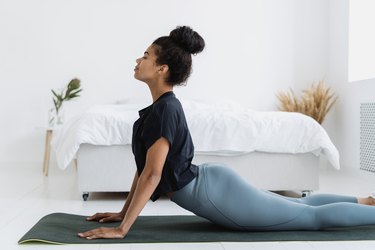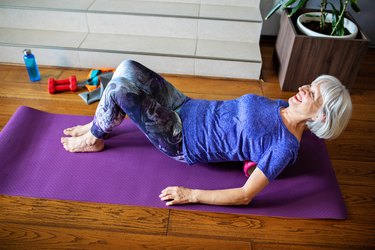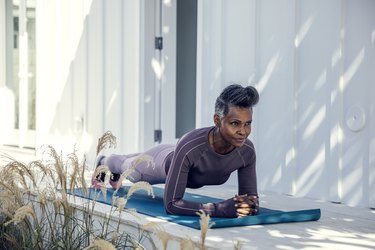
If you seem to be shrinking the older you get, it's not an optical illusion. Loss of height is just one of the many ways our posture changes as we age. But are these shifts in stature inevitable?
Here, experts explain how posture may become altered in later stages of life and what we can do to manage (and possibly even delay) it.
Video of the Day
Video of the Day
3 Ways Your Posture Changes With Age
1. We Become More Stooped
You may have noticed that some seniors appear to be stooped forward. That's no coincidence: A less upright posture is the product of aging.
"As we age, our [spinal] discs lose fluid and become 'flatter,'" says Gbolahan Okubadejo, MD, a New York City-based spinal and orthopedic surgeon.
In other words, the discs between each vertebra have less water and become more brittle. The result: Less space between the joints, says Meghan Lamothe, PT, DPT, a physical therapist at the Hospital for Special Surgery in Manhattan.
Here's the thing: As the space between each vertebra grows smaller, you stand less upright (think: hunchback).
And "because discs are naturally taller in the front, we have more loss anteriorly," which also contributes to the curving-forward phenomenon, Dr. Okubadejo says.
So, why does the water in our discs decrease? It's just part of the aging process. "Discs lose fluid naturally — it's like graying hair," Dr. Okubadejo says.
And the process starts earlier than you might think — in your 30s, Lamothe says.
"Furthermore, many older adults begin to manifest osteopenia [a loss of bone mineral density] and osteoporosis [a disease that weakens bones] with age," Dr. Okubadejo says. "This can lead to micro fractures that cause loss in the height of vertebral bodies, which all amounts to a more stooped posture," he explains.
Making matters worse, age-related muscle loss (also known as sarcopenia) also comes into play, Lamothe says. In fact, after you turn 30, you'll lose up to 5 percent of your muscle mass every decade, according to Harvard Health Publishing.
And that's particularly problematic for posture. Here's why: "The biggest area where we lose muscle mass is in the core (i.e., in the front of the torso)," Lamothe says. And a strong core is what keeps us upright.
So, once your core muscles wither and weaken, it's a domino effect from there: "Gravity exerts its force to bring the top half of the body forward," making it more rounded and stooped, Lamothe says.
2. We Lose Height
The reason we grow shorter as seniors is caused by the same mechanism that curves our spine and makes us more stooped: "Loss of hydration of the discs and thinning of the vertebral bodies," Dr. Okubadejo says. This all results in a relative flattening of the discs and a shorter stature.
"The biggest area where we lose height is the spine (although arthritis and other joints in the body also play a role)," Lamothe says.
Indeed, starting in your 30s (noticing a trend?), you'll lose approximately a half an inch of height every decade, according to the Medical University of South Carolina. You're unlikely to notice these gradual changes until you hit your 70s, though, which is when this height loss becomes more noticeable.
3. Our Gait Changes
If you have a signature stride, it may slightly shift in your golden years. Yep, even the way we walk is affected by age.
In general, our steps become shorter (in length and height). And these shorter strides are directly related to the stiffening of joints that comes with aging, Dr. Okubadejo says.
This happens because, as we age, all our tissues (think: muscles, tendons, ligaments and other connective tissues) become much less viable, elastic and powerful, Lamothe says.
This is due to less water content but also age-associated muscle loss. Because we have fewer type two muscle fibers, we also have less power and strength, Lamothe says. And all these factors limit the length of our steps.
And while more petite paces may sound like NBD, they can actually increase your risk of falling, Lamothe says. Think of it like this: If you don't pick up your feet enough while you walk, you're more likely to trip and take a tumble.
Case in point: One in four elder Americans will take a spill each year, and a fifth of these falls will result in a serious injury, such as broken bones or a head trauma, according to the Centers for Disease Control and Prevention.
Related Reading
Everyone will experience a shift in their posture — to some degree — as they approach their later years. "It's a normal part of the aging process," Lamothe says. "And while you can't prevent these physiological changes from happening, you can certainly slow the progression significantly."
Here are a few smart strategies to manage (and possibly postpone) postural changes.
1. Start Strength Training
Strength training not only helps to maintain muscle mass, which as we know, plays a pivotal role in proper posture, but it can also have a direct effect on key muscles that are necessary for keeping you in an upright position, Lamothe says.
For example, strengthening the scapular (i.e., your shoulder) muscles can assist with correcting posture. That's because when these muscles are strong, they will pull your shoulder blades back (read: combat shoulder slump and stooping) and help you stand in a more vertical, lifted position, Lamothe says.
Rows — or any exercise that involves retracting the shoulder blades and squeezing them together — are optimal options.
Try These Exercises
"It is also critical to work on core strengthening," Dr. Okubadejo says. "With a stronger core, our bodies naturally fall into better alignment," he explains.
Put another way, a strong core helps keep your torso upright. But keep in mind, your core consists of more than just your abdominals. "Everyone thinks the core is just the front, but it's also the sides (i.e., your obliques), and even the muscles in the back, which really need to be strong because they literally hold us vertical," Lamothe says.
To hit all these core muscles, Lamothe recommends side planks. This plank variation is easily adaptable to all skill levels, she says. You can modify them (by doing them on your knees) or progress them (by adding movements like a hip dip or leg raise) as needed.
How to Do Side Planks
- Lie on your left side with your legs extended out straight and your feet stacked one on top of the other.
- Place your left hand under your left shoulder.
- Lift your hips off the ground so that you're supporting your full weight on your left hand and left side of your left foot.
- Ensure your neck is neutral, take a deep breath out and tighten your core.
- Focus on your hips: Does it feel like the bottom one is sagging? Lift them a few inches higher. Do you feel like your body is making a rainbow shape? Lower them down to a more neutral alignment. You should feel your bottom obliques engage without crunching them in half.
- Continue to breath as you hold this position for 10 to 60 seconds.
- Repeat on the right side.
2. Prioritize Posture Exercises
Having a daily stretching regimen with a strong emphasis on posture is another necessity when your goal is to combat age-related postural changes, Dr. Okubadejo says.
Lamothe agrees: The one thing that most of us lack in our everyday routine is a focus on posture-specific exercises. "People often don't learn this stuff until they have pain or some other issue and come to physical therapy," she says.
But incorporating movements to improve your mobility and flexibility is fundamental to maintaining good posture as you age. So which exercises are best?
"Think of everything [in your body] being stacked like blocks, one on top of the other," Lamothe says. "We just need to do exercises to help facilitate that [proper alignment]," she says.
For better posture, Lamothe suggests doing gentle movements (most you can even do seated) throughout the day:
Twisting from side to side (in your chair) to rotate through the thoracic spine: We spend most of our days (and our lives in general) moving in a forward (sometimes backward) plane, Lamothe says. Including rotational movements into your day will keep your joints limber and mobile.
Thoracic extension over the back of the chair (think: doing a backend): This reverses the excessive flexion in the mid-back (which contributes to stooping) and opens up the chest as well, Lamothe says.
Chest-opening doorway stretch: Lift your arms into goal posts on either side of the door frame, step through the doorway with one foot and hold the stretch for up to a minute. Remember: Your chest should be in front of your shoulders, Dr. Okubadejo says. This chest-opening stretch can help counteract slumped, rounded shoulders.
Chin tucks: Chin tucks can help keep the head aligned and neck in a neutral spine position, Lamothe says. Essentially they serve to counterbalance the act of poking your chin forward and straining your neck (which is the default posture most of us take when sitting at the computer or scrolling through our phones).
How to Do a Seated Chin Tuck
- Sit up straight on a firm surface.
- Squeeze your shoulder blades together and down, aiming toward your back pockets. Maintain this position throughout the exercise.
- Looking straight ahead, pull your chin backward, as if you are making a "double chin."
- Hold for one to two seconds; then relax — but don't slouch.
- Repeat eight to 10 times.
"I encourage my patients to do these stretches throughout their workday because so many people are sitting at a desk for prolonged periods," Lamothe says. "And when you intervene on something like that in the 30s, 40s or even 50s, it can definitely help someone, so that they're not so stooped over by the time they turn 70," she says.
3. Eat a Well-Balanced Diet
Believe it or not, what you put on your plate plays a part in preventing poor posture as you age.
For instance, getting plenty of protein is probably the most important thing you can do for healthy posture, Lamothe says. That's because proteins are considered the "building blocks of life," according to the U.S. National Library of Medicine. Indeed, you need this mighty macro to build and repair muscle tissues.
But protein is only a fraction of the equation. A posture-promoting diet wouldn't be complete without carbohydrates. Lamothe stresses consuming heathy carbs (think: fiber-rich whole grains) — particularly after exercise — because they help refuel your system and recover.
Put simply: They give your body the energy it needs to stay strong.
4. Maintain Bone Health
If you want to have healthy posture down the line, maintaining healthy bones is a requirement. That's because age-related issues such as osteopenia and osteoporosis can weaken your bones and contribute to postural changes like stooping and height loss.
To improve bone mineral density, once again, exercise is essential. And weight-bearing moves are a must. Bodyweight moves (like squats) are a stellar example. But "as long as you're standing on your feet, even if it's just walking, that's great," Lamothe says.
The point is simply to put your weight on your bones to keep them sturdy and strong, she says.
In addition, dietary intake of calcium and vitamin D are also necessary for bone health, Lamothe says.
The recommended intake of calcium and vitamin D is 1,300 milligrams (mg) and 20 micrograms (mcg), respectively, for adults, according to the U.S. Food and Drug Administration (FDA).
If you're not getting enough of these essential nutrients in your diet, speak with your doctor about ways to supplement.
5. Don’t Smoke
If you haven't already stopped smoking, here's another reason to quit.
"Smoking causes vasoconstriction (i.e., it constricts your blood vessels)," Lamothe says. That means it affects blood flow to your bones and muscles, she explains. But when these tissues don't receive the nutrients and oxygen they need, they can't function optimally.
This vasoconstriction can even delay your healing process if you have an injury, Lamothe adds.
All this is to say, when your muscles and bones aren't healthy, your posture will suffer.
6. Move as Much as Possible
Even if you can't fit in a focused sweat session, all the little movements you do in a day can help when it comes to posture. "Motion is lotion," Lamothe says. That's because moving of any kind lubricates the joints and keeps them mobile (read: healthy).
And don't worry about picking a particular exercise — just do what feels good.
"You need to find happiness in the exercise that you're doing," Lamothe says. "It should be fun because we need those endorphins."
At the very least, try standing for one minute every hour. Putting weight on your bones will strengthen them. "Even just one minute makes a difference," Lamothe says.
- Medical University of South Carolina: “Posture Change With Age”
- Harvard Health Publishing: “Preserve your muscle mass”
- Centers for Disease Control and Prevention: “Keep on Your Feet—Preventing Older Adult Falls”
- U.S. Food and Drug Administration: “Daily Value on the New Nutrition and Supplement Facts Labels”
- U.S. National Library of Medicine: “Protein in diet”
Is this an emergency? If you are experiencing serious medical symptoms, please see the National Library of Medicine’s list of signs you need emergency medical attention or call 911.


